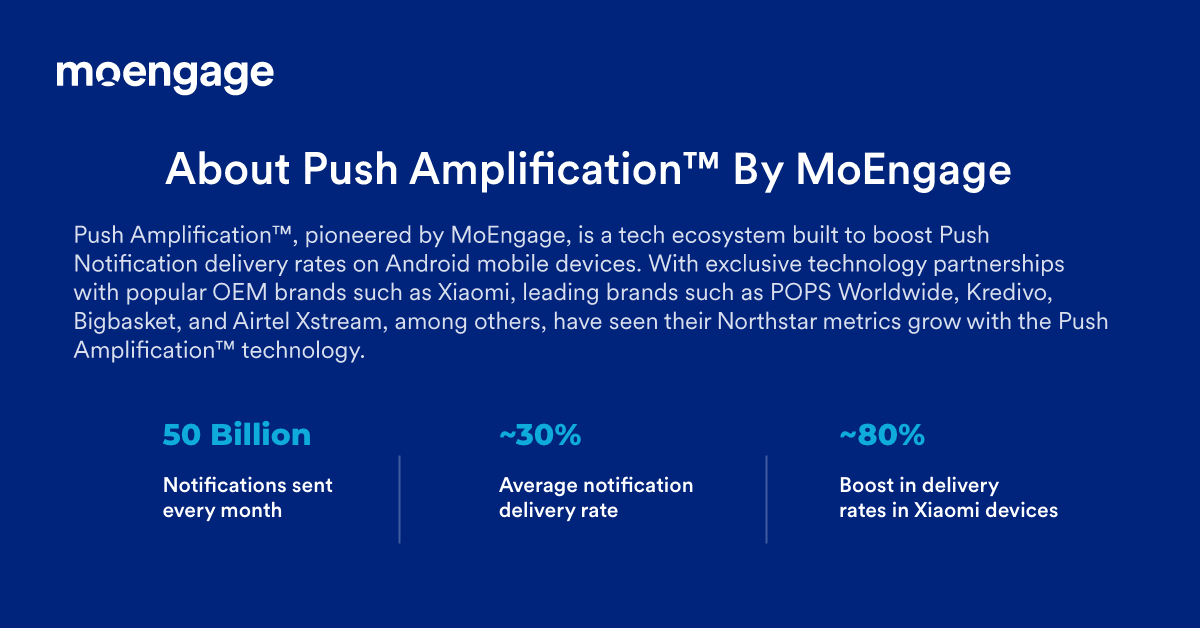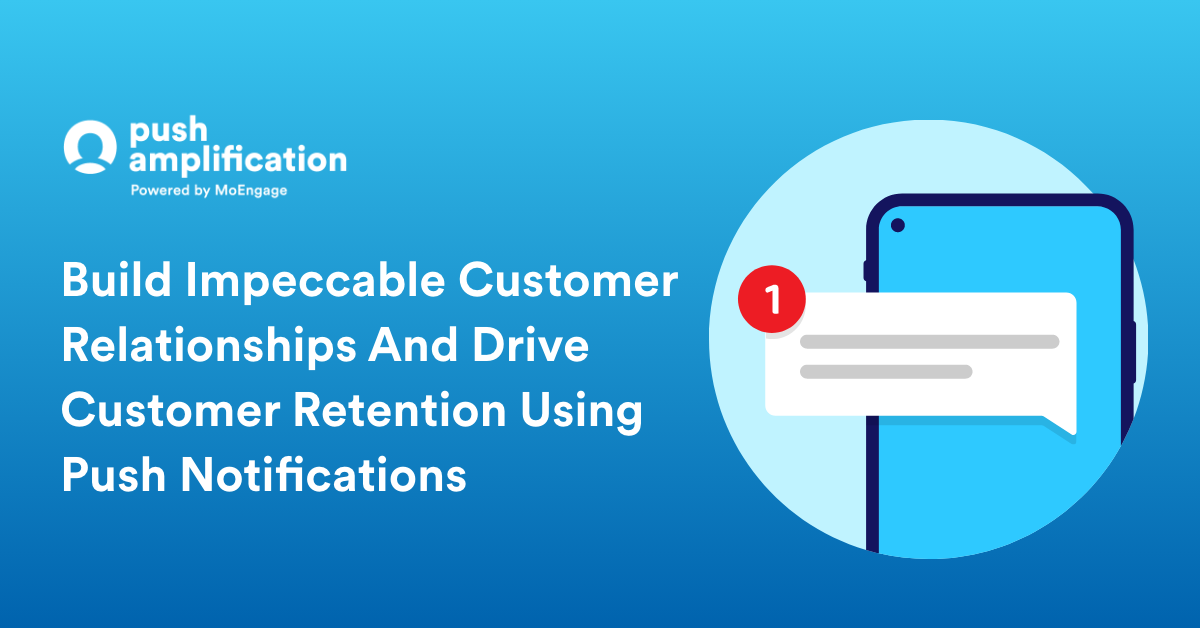The Importance of Real-time Marketing
There truly is no replacement for real-time marketing. With this type of marketing, brands can not only take advantage of peak moments of their business to engage with their customers but also differentiate themselves from their competitors and improve the overall customer experience.
Be it online or offline real-time marketing enables brands across industries to deepen existing customer relationships, support a sense of urgency to garner users’ attention, share thoughtful reminders, increase the quality of engagement, and offer them a way of diversifying the content.
A principal aspect and the easiest way of adopting real-time marketing is opting for Push Notification campaigns! But before we dive into the reasons behind their supremacy, let’s dive into what push notifications are and how they can help your brand.
What are Push Notifications
Push Notifications are becoming more and more popular with brands nowadays, and with good reason. They are a great way to engage your customer without being intrusive.
These small pop-up messages sent to your users’ devices appear even when they aren’t using your app in real-time; all primarily designed to grab your mobile app users’ ever-fleeting attention. There are innumerable benefits of push notifications, which include improving customer retention, boosting customer loyalty, and improving overall customer engagement.
Why Send Push Notifications
Push Notifications are one of the handiest tools marketers can use to engage their customers in a personalized, real-time manner- especially mobile push notifications. The goal is to drive user engagement on your brand’s mobile apps and reach your target audience when they’re most receptive to your brand through these push messages.
Benefits of Push Notifications
The constant stream of promotional, relevant content pushed through mobile push messages also has the potential to create a sense of urgency for your audience.
That is why so many brands have started incorporating compelling Push Notifications into their customer engagement strategy.
By implementing a push-notification strategy, brands can regularly engage their customers with relevant messages and keep them interested by sharing new, targeted information or promotions. As a result, sending push notifications can help brands build customer loyalty, promote customer acquisition, uplift conversion rates, and help in increasing user retention rates.
Impact of Push Notifications
According to a report by Statista, India had over 749 million internet users in 2020. This figure is projected to grow to over 1.5 billion users by 2040, suggesting a significant market potential for internet services.
Even the IAMAI-Kantar ICUBE 2020 report indicates that India’s active Internet users are expected to reach 900 million by 2025! This upsurge shows that the digital market is growing exponentially, and brands must focus on creating bespoke customer engagement strategies to reach their target audience.
Push Notifications are highly engaging and reliable channels that help you reach, engage, and retain your users.
Different Types of Mobile Push Notifications
Whether promotional, transactional, auto reminders or geo-targeted, push messages instantly reach your target audience on mobile devices or the web. They encourage your customers to return to your site or app and help you boost your brand’s revenue by driving sales and promoting special offers.
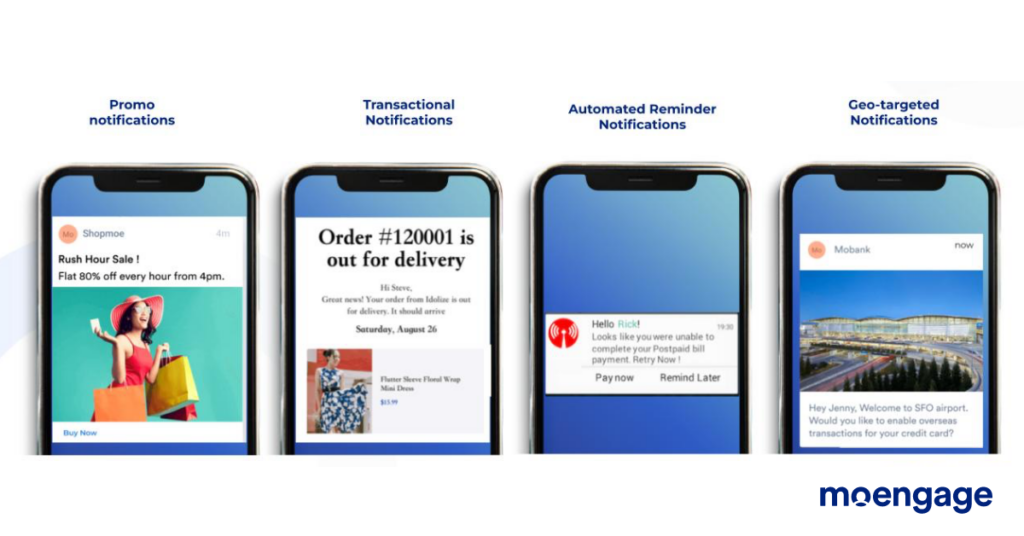
When push message campaigns are executed properly, the scope of growth is endless.
To date, we have observed some essential findings that have helped us understand the extent of the power that lies behind using Push Notifications campaigns:
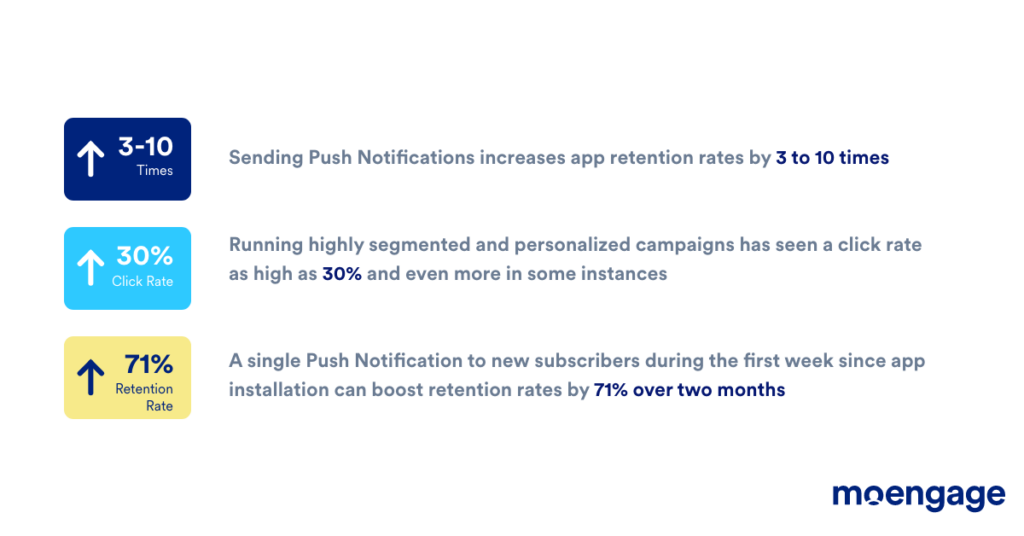
A strong push notification campaign helps build trust, encourages return visits, directs customers’ interest to the most effective content, and helps the customers stay updated about the brand in the best way possible.
Advantages of Successfully Executed Push Campaigns
With every undelivered push message, you might miss the opportunity to engage, convert and retain more customers.
Here’s a glimpse at what you’re missing out on as a brand if you still haven’t invested in a bespoke push message campaign strategy:
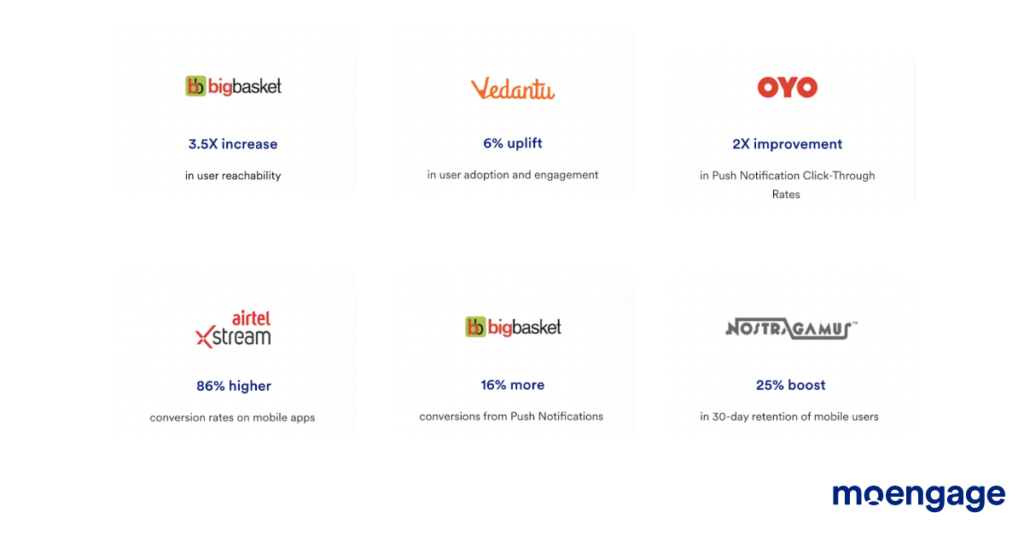
Now that we agree that using Push Notifications is a great way to strengthen your relationship with customers and drive business results, let’s look at how they work and where the challenge lies.
The Push Process
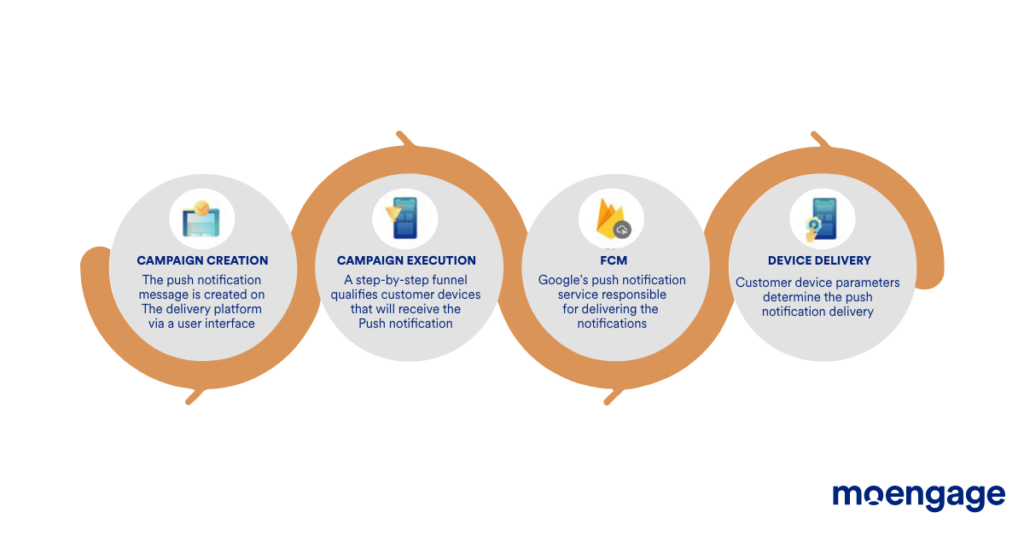
Firstly the push message is created on the delivery platform via a user interface. Secondly, a step-by-step funnel qualifies customer devices that will receive push notifications. Then Google’s push notification service is responsible for delivering these push messages. Lastly, customer device parameters determine which user’s device will be receiving push notifications.
So, where does the issue lie?
The Challenge
You plan to reach about 100 customers that satisfy your segmentation criteria and have installed your application on their devices. Now over that, there can be specific business capping that you’re implementing, e.g., Frequency Capping (FC) in terms of how many times you’d like each customer to receive the Push Notifications, etc.
After filters like these, there will also be a significant and noticeable drop in the number of users your push campaigns will reach owing to the Active Tokens, i.e., the number of devices active for the customers satisfying the criteria mentioned above.
The number of successfully sent Push Notifications will also witness a drop owing to the capabilities of different mobile notification services like GCM (i.e., Google Cloud Messaging) or APNS (i.e., Apple Push Notification Service).
Additionally, not all Push Notifications get delivered! The likelihood of your push campaigns getting delivered to your targeted customers is relatively low.
While various factors impact Push Notification delivery, the type of devices your customers use is important.
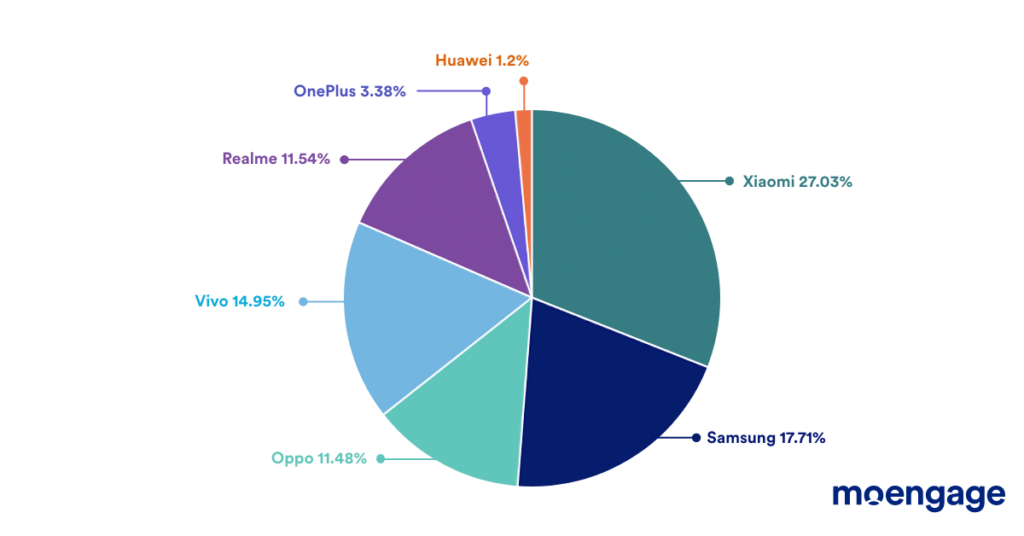
Market share of Android Manufacturers in India
This is because several popular Chinese OEMs dominate the Asian Android devices market. These OEMs, of course, come with their optimizations for battery saving, performance, etc., over the Android platform.
This means that the probability of your push landing on the mobile device is unequal across all the manufacturers, as mentioned earlier. With the market so heavily fragmented, over 40% to 70% of Push Notifications go undelivered! As a result, your downstream conversion and engagement also take a hit.
And while some companies may argue that their delivery rates for push campaigns are higher, they often need help to bring in engagement equivalent to those rates.
That is because they need to measure their delivery rates correctly.
Most brands fall into the trap of calling the successfully sent Push Notifications to reachable devices their delivery rates. It’s comparable to an E-commerce brand measuring its success on simply the total number of packages shipped. It can only be considered a successful delivery once your customers receive their packages.
Similarly, the delivery rates for Push Notifications need to be measured based on impressions made, i.e., customers that receive the notifications versus the successfully sent Push Notifications.
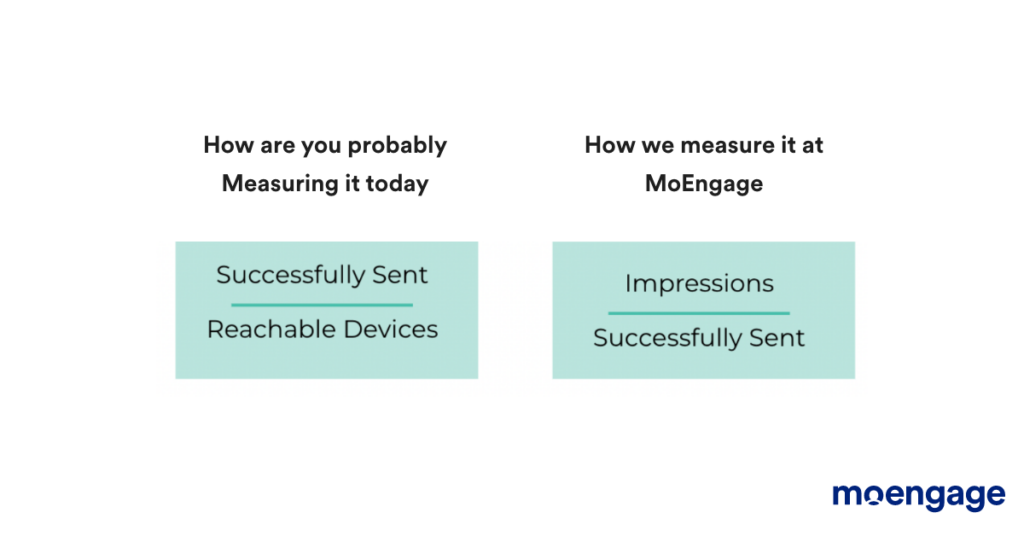
Here’s a glimpse at the real delivery rates across industries in India.
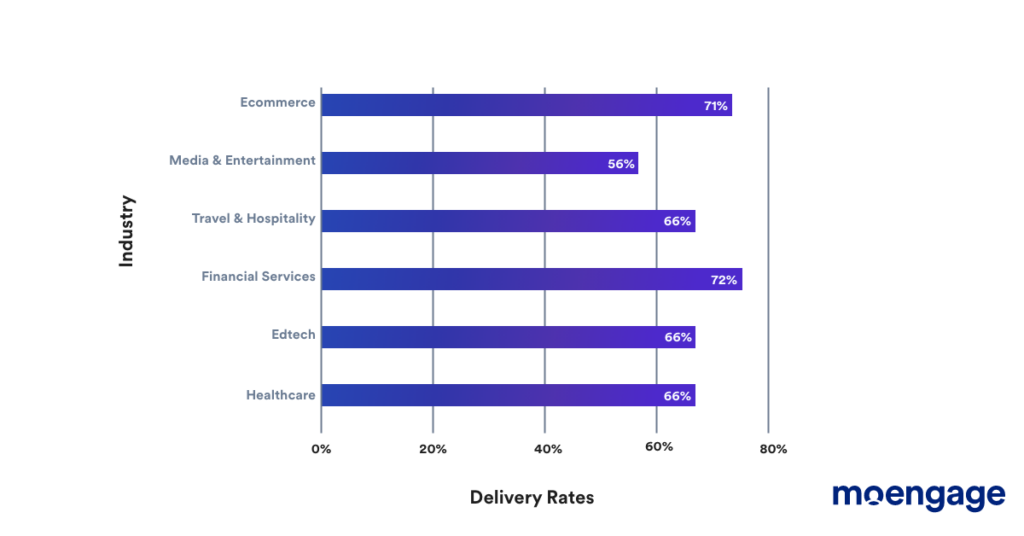 Delivery Rates by Industry Verticals (FCM, i.e., Firebase Cloud Messaging)
Delivery Rates by Industry Verticals (FCM, i.e., Firebase Cloud Messaging)
The Link Between App User’s Activity and Push Notifications Delivery Rates
It’s important to note that the rate at which Push Notifications are delivered varies substantially depending on the type of app and how it is used as well.
This is mostly due to the fact that different brands and industries have distinct use cases when it comes to parameters like recency (clicks), the number of clicks, recency (app opens), and the number of sessions. Some apps are utilized more often than others. As a result, Push Notification delivery rates are affected significantly.
Shopping apps, for example, have higher Push Notification delivery rates than other apps. Another example of peculiar app usage and a consequential difference in delivery rates is in the case of grocery delivery apps.
Since the pandemic, the recency and frequency of app usage have increased for grocery delivery apps compared to travel-related apps.
The highest delivery rate of over 80% has been observed for apps that had app activity (customer) in the last 24 hours.
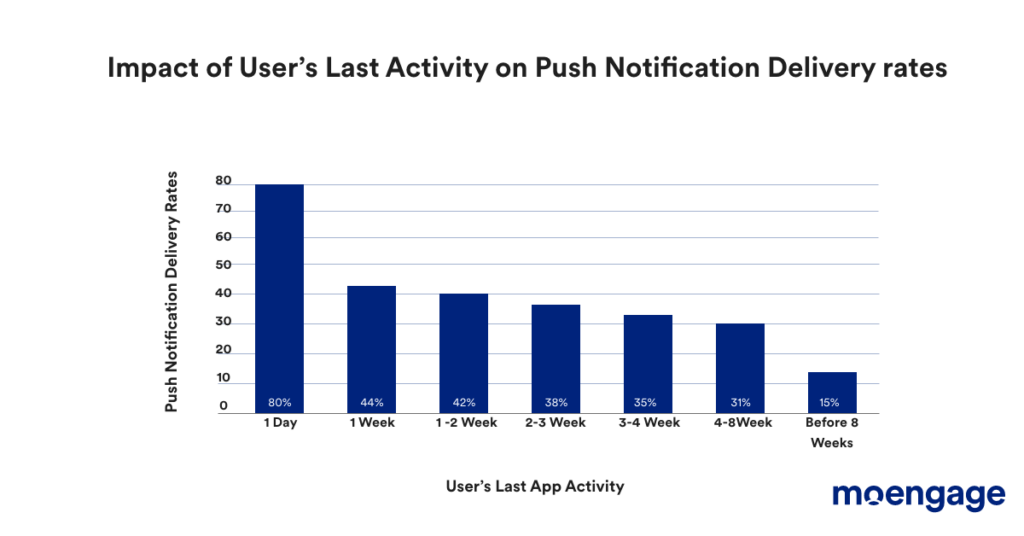
Impact of User’s Last Activity on Push Notification Delivery Rates
Therefore the more inactive your brand’s customers are (on apps and websites), the more the reachability of your push campaign decreases. So it’s imperative to optimize and improve the customers’ app interactions.
With the right tools and mar-tech stacks, there is a huge scope for improvement to increase your Push Notification delivery rates and to make sure your push campaign actually reach your target audience.
Therefore the more inactive users of your brand (on apps and websites), the more the reachability of your push campaign decreases. So it’s imperative to optimize and improve the customers’ app interactions.
With the right tools and mar-tech stacks, there is a huge scope for improvement to increase your Push Notification delivery rates and ensure your push campaign reaches your target audience.
Push Amplification® Breakthrough
With the Push Amplification® technology, MoEngage has been pioneering this space by providing a solution to all the issues mentioned above at hand when it comes to boosting Push Notification delivery rates. Our technology:
- Helps businesses identify undelivered Push Notifications
- Acts as a fallback mechanism to Firebase Cloud Messaging (FCM)
- Directly delivers those Push Notifications to customers’ devices
Thereby amplifying the overall delivery rates of the Push Notifications.
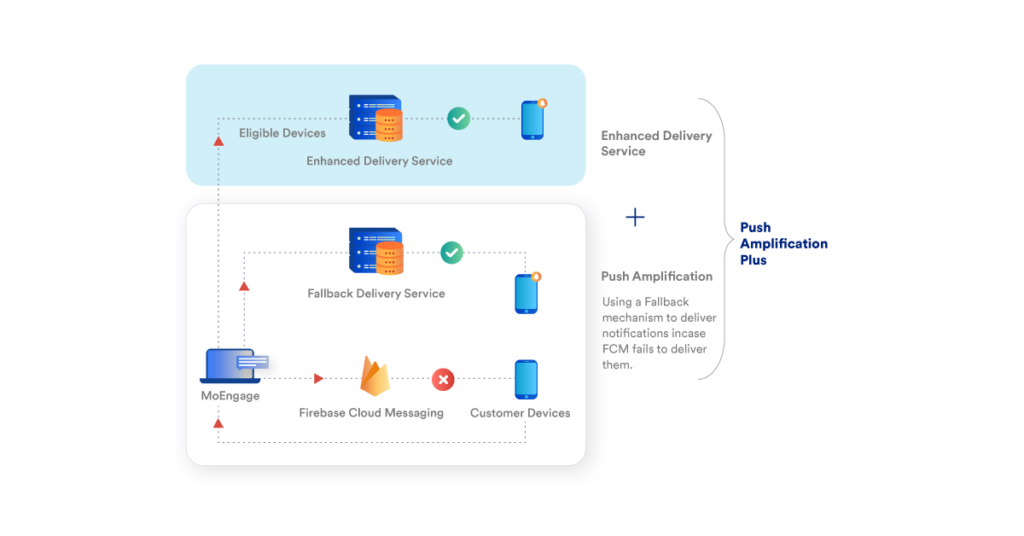
With our Push Amplification® Plus technology, we’ve taken it a step further by gaining Exclusive Access to deliver Push Notifications through an OEM’s own push service’s system channel.
It’s worth mentioning that this service is constantly on and cannot be turned off or disabled by the device’s owner.
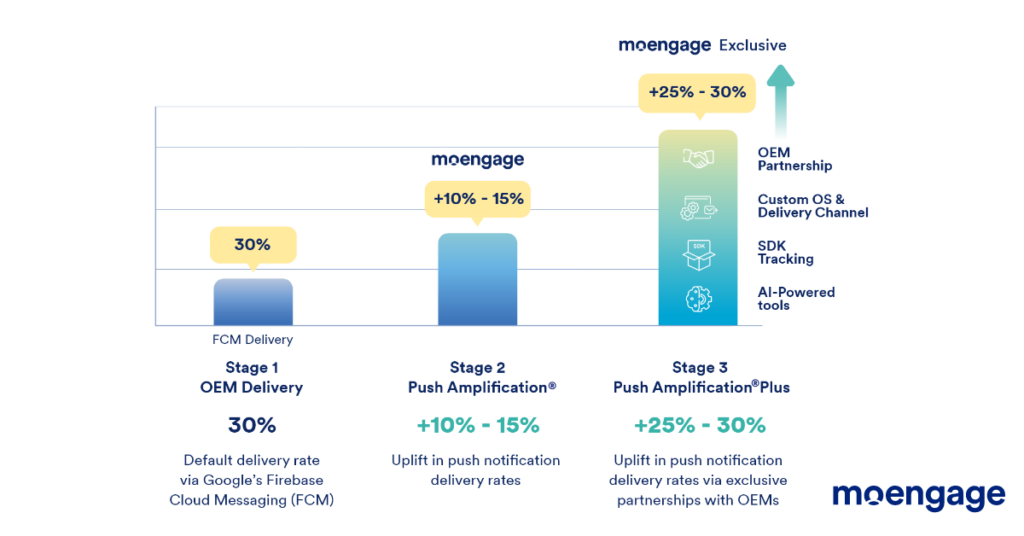
The default delivery rates via Google’s Firebase Cloud Messaging (FCM) lie somewhere around 30% only.
Success That Businesses Have seen Using MoEngag’s Push Amplification® and Push Amplification® Plus Technology
With our power-packed Push Amplification® and Push Amplification® Plus technology, businesses have seen a 10-15% and 25-30% uplift in their Push Notification delivery rates. Even across industries in India, we see a significant improvement in the delivery rates with our technology vs. FCM delivery.
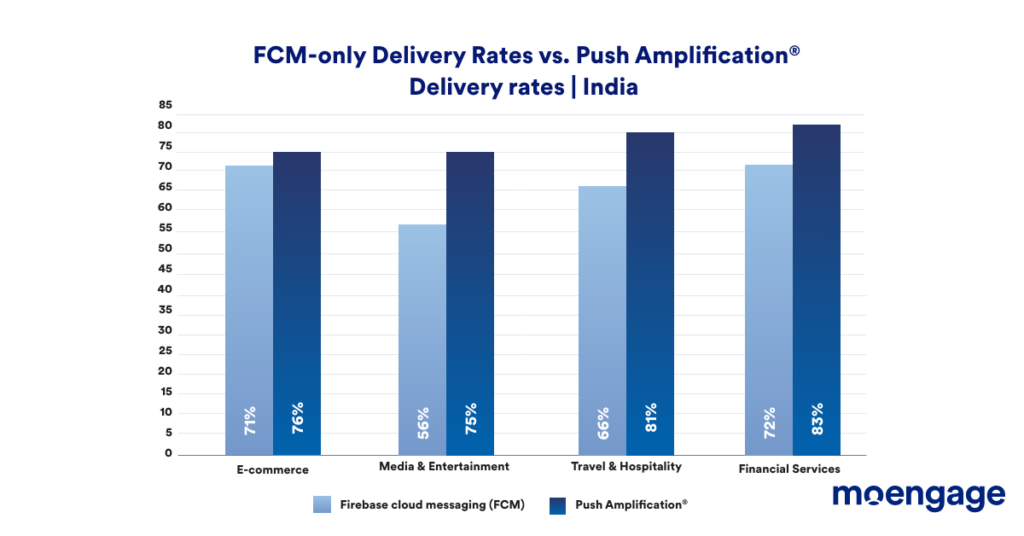
In the case of FCM, the older the Push Notification campaign, the more significant the drop in the delivery rates. But with Push Amplification®, brands are able to revive older customers even better since the reachability to older app/web customers is even higher.
In the case of FCM, the older the Push Notifications campaign, the more significant the drop in the delivery rates.
But with Push Amplification®, brands are able to revive older customers even better since the reachability to older app/web customers is even higher.
Using Push Amplification® Plus, which increases push notification delivery rates by up to 40% across Android device manufacturers.
Making the Right Decisions For Your Push Notification Strategy
Sending Push Notifications to your customers can clearly be a very efficient way to interact with them and increase user engagement. However, the idea is to strike a balance between capturing attention and not becoming obnoxious in the process by sending too many notifications.
If you get it right, the benefits can be exceptionally rewarding because the bottom line is that push notifications work. Marketers simply need to crack the code behind what works for their audience. Personalized notifications that cater to what their customers’ user behavior dictates are the goal.
Choose MoEngage to Optimize Your Push Notification Campaigns
MoEngage’s Push Amplification® technology helps you facilitate that by boosting Push Notifications’ deliverability and helping your Northstar metrics grow.
So what are you waiting for? Click the link below and get in touch with a Push Amplification® expert at MoEngage!
